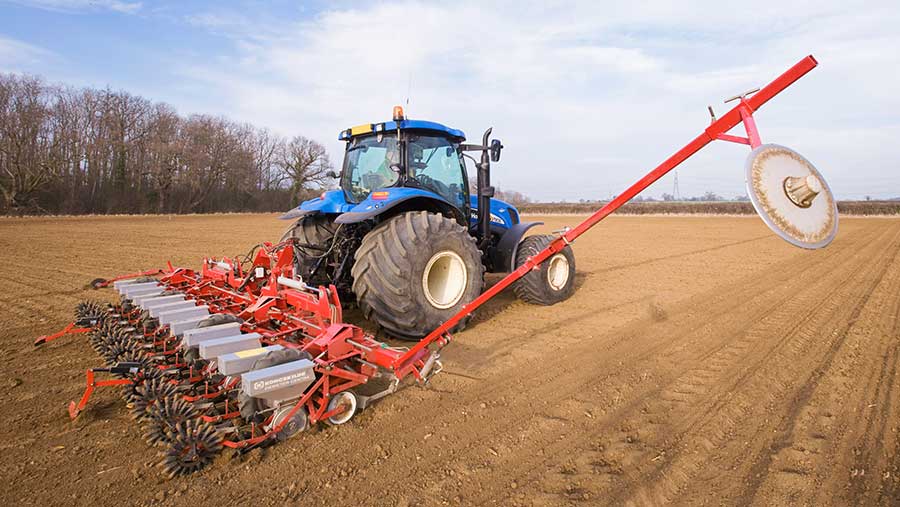Outlook 2020: Delicate issue of scale for root crop growers
 © Tim Scrivener
© Tim Scrivener Last year we described the 2018 potato growing season as “the most challenging in recent history”, but the 2019 harvest will now be remembered for the same reason.
It remains to be seen whether two consecutive difficult seasons will affect the trend to ever-increasing areas, says Andersons’ Nick Blake.
This autumn will have serious financial implications for many growers, the effects of which could call into question the ongoing viability of some businesses.
See also: Why non-flail potato desiccation is still an option post-diquat
Key advice for 2020
- Review water availability and future irrigation requirements.
- Carefully consider management implications before increasing crop area.
- Critical field selection will contribute to overall crop profitability. Consider cropping history, drainage, soil type, fertility, water availability and distance.
- Consider effect of diquat ban on cost of production for 2019.
- CIPC ban – use advice from Sutton Bridge Crop Storage Research.
AHDB figures show a significant decline in the number of growers with smaller areas of potatoes (less than 99ha) since 2003, while those with larger acreages (>100ha) have increased.
This trend increases the risk taken by individual growers, and highlights the need for adequate capital, and return.
“Although this is hardly surprising, the higher end of the 30-99ha category and lower end of the 100-299ha group could include some of the most resilient growers,” says Mr Blake.
Interestingly, the AHDB also reports that between 2013 and 2018 there was a slight drop in the planted area for the 100-299ha category, and only a small increase in the largest (>300ha) category.
“This may suggest a halt to the trend for an ever-increasing area per business, and a recognition of the issues related to the management of large areas/ tonnages, which inevitably means more travelling distance, rented land and stores,” he says.
Market outlook 2020
Farmers Weekly gets expert insights into the markets and prices for farmers across the sectors to help with making business decisions in 2020.
Water availability
Water availability is an increasing issue for growers and Mr Blake expects unirrigated land to account for a smaller proportion of total production in the longer term.
“In quality terms, irrigation can make the difference between a marketable crop, and one that ends up as livestock feed. It will often mean the difference between profit and loss.”
However, the benefits of more certainty in quality and yield must generate a proper return, given increased risk as extra costs will be incurred in labour, energy, infrastructure, and third party costs.
This adds to overall cost of production and increases working capital, he says.
Sugar beet
A marginal increase in the basic 2020 price against the 2019 contract is welcome news for growers, especially given the drop in gross margins for alternative crops over the past year, driven by lower cereals prices.
A change in tare policy has caused confusion among some, though, prompting the NFU to issue written clarification prior to contracts being returned.
See also: The secret to Norfolk farm’s record-breaking sugar beet yield
Key advice for 2020
- Continue reviewing production methods and costs, including options for harvesting and haulage.
- Identify potential business or agronomic improvements to “future-proof’ businesses as policy and regulations change.
The 2020 price is based on a zero crown/historic crown basis, which means more tonnes will be paid for, hence a reduction in the price a tonne, Mr Blake explains.
For a one-year contract, this means a new price of £19.60/t, equivalent to £20.99/t on the previous crowned basis.
Looking ahead, Mr Blake believes the sugar sector may have less to fear from Brexit than other commodity sectors.

© Tim Scrivener
Under no deal, the government proposes current import tariffs will be applied, which, given the UK is not self-sufficient in sugar production, could create an opportunity for domestic growers.
Assuming the UK leaves the EU, the current EU reference price-based bonus mechanism will be replaced by an independent auditor, who will determine the bonus price based on several factors, including British Sugar’s export sales by value and tonnage.
The prospect of beet production falling to fewer growers with larger areas brings a perception that this reduces production costs, says Mr Blake.
”There are significant challenges. Management overstretch, mechanisation, logistics and geography all mean it can be more difficult to derive direct scale benefits than is often believed.
“The difficulty of finding a profitable break crop is a common issue for many arable businesses. If it wasn’t for soil type and location, some would be happy to have sugar beet in their rotation, although the reward has to take into account damage to soils and infrastructure.”
Farmers Weekly says
After the wet autumn, maincrop potato growers in particular will be hoping for an easier season next year. However, there will be no let up, as it will be the first without diquat.
Spud growers have been particularly hard hit by the loss of actives, with sprout suppressant CIPC also among the casualties having already lost the herbicide linuron.
Sugar beet is having a reasonable season with British Sugar forecasting yields higher than 2018 and beet yellows virus has not been as severe as feared after the loss of neonicotinoid seed treatments.
But the loss of Biscaya means growers have only one foliar spray option. One positive is the arrival of herbicide tolerant sugar beet, which will help in the battle against weeds.
Richard Allison, Farmers Weekly arable editor
